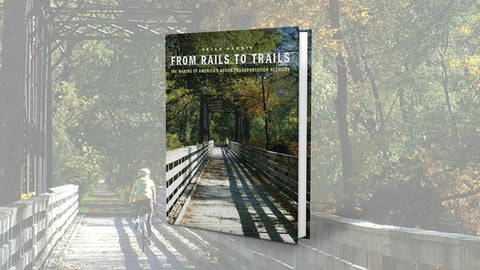
‘The Making of America’s Active Transportation Network’ Review: Riding The Old Railways
Even if you don’t bicycle, chances are you have traversed one of the 2,295 rail trails stretching 25,000 miles nationwide. Strolled New York City’s High Line? That’s a rail trail. In The Making of America’s Active Transportation Network , Rails-to-Trails Conservancy co-founder Peter Harnik expertly guides readers down the twisted path connecting the Age of Rail and the Age of Pedal. Non-cyclists will find ample material of interest in his brisk 238-page narrative, which starts in the 1800s with the history of railroad, interurban, and trolley systems. This tangled tale involved classic Robber Baron behavior as private companies, enabled by massive federal land grants, built competing lines to haul freight and passengers, sometimes practically within sight of each other. Brushing aside brief challenges from canal systems like the Erie and the Chesapeake & Ohio, rails soon ruled the national transportation roost. One measure: in 1888, trains moved some 6.5 billion pieces of mail over 126,000 miles of railway.
The rail system’s chronic inefficiencies led to massive mergers and consolidation. Harnik pegs the height of railroading as 1916, by which year lines already were slashing redundant trackage. A fin de siècle bicycling boom, which had gotten rolling with high-wheelers and grew in popularity with the Columbia Safety Bicycle, had already come and gone the way of handlebar mustaches. Unconsciously obeying the law of unintended consequences, cycling lobbyists launched the Good Roads Movement, which literally paved the way for motor vehicles and demoted the bicycle to a toy kids rode to school and goofed around on, except when pedaling to deliver newspapers.
Rail clung to its dominance as a means of personal travel and freight lugging—along with a shred of its glamour—until the 1950s, when airliners and interstate highways largely supplanted trains. Railroading, still a $70-billion-a-year industry, hardly disappeared, but nationwide between 1916 and 2010 rail companies abandoned 54.4 percent, or 138,694 miles, of extant track and the bands of land those tracks occupied.
The 1960s saw fitness and environmentalism begin to come into vogue. Bicycling enjoyed a comeback among adults that deepened and accelerated amid the 1970s gas crises. While the rise of the Schwinn Varsity as the preferred campus vehicle did not lead directly to the rails-to-trails movement, cycling’s popularity suggested a renascence for rust-ridden rail corridors.
A Washington insider in environmental policy, Harnik excels at interweaving many disparate political strands, from grassroots activism to Congressional sausage-grinding, into a cohesive narrative. Deals were cut, enabling legislation reinterpreted with muscular imagination, opposition from rail buffs thwarted or co-opted, names named, sausage made.
Harnik’s sweep through this lane of American transportation, industry, and politics will engage the most sedentary. Buffs will geek out on the dozens of charts, maps, and tables. My favorite: selected railroad nicknames, such as the Lake Erie & Western—“Leave Early and Walk.” —Boulder, Colorado-based Michael Leccese has written and edited books on cycling and urban planning. He has effectively bicycled to the moon, logging 250,000-plus miles touring, commuting, making day trips, running errands, and towing his Australian shepherd, Piper, in a bike trailer.
The Making of America’s Active Transportation Network
By Peter Harnik
University of Nebraska, 2021
If you buy something through our site, we might earn a commission.
This book review appeared in the Winter 2023 issue of American History magazine.
GET HISTORY 'S GREATEST TALES—RIGHT IN YOUR INBOX
Subscribe to our HistoryNet Now! newsletter for the best of the past, delivered every Wednesday.
Close
Thank you for subscribing!
Submit
